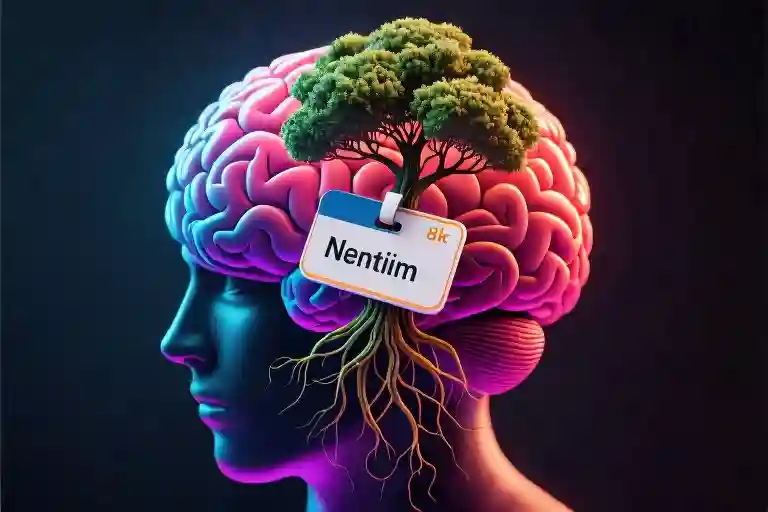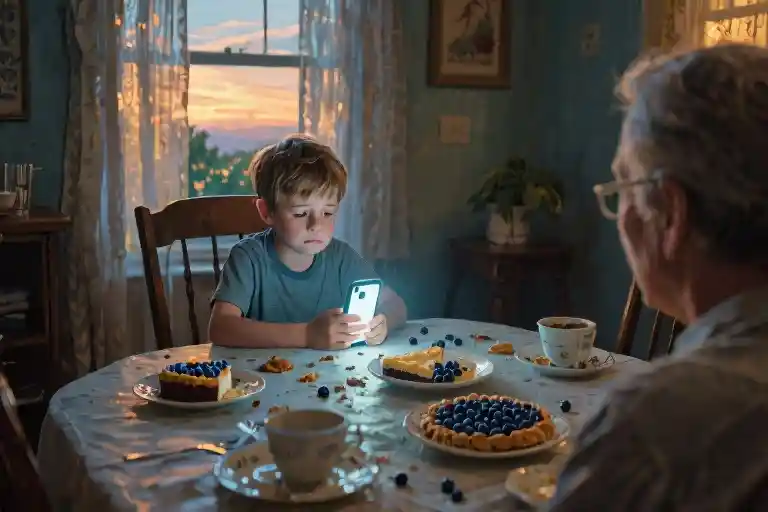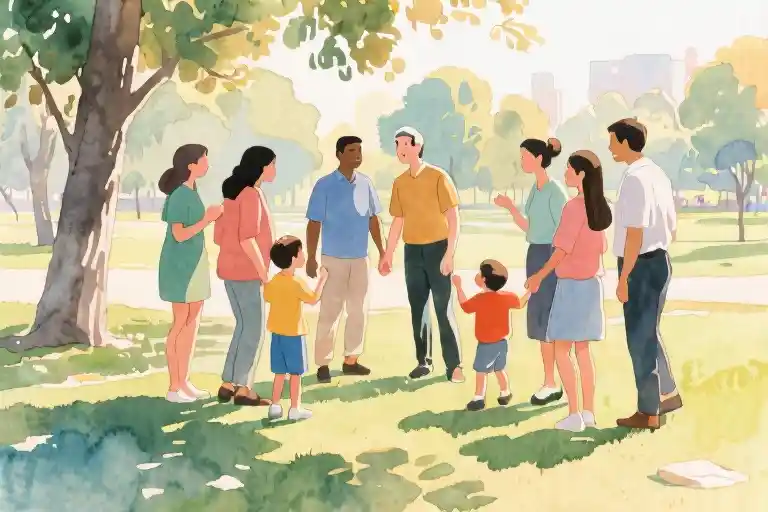The leather-bound college journal feels strangely light in your hands now, its pages yellowed at the edges like autumn leaves preserved between chapters of a life. Beside it on the desk, your child’s glossy graduation album winks under the lamplight – two artifacts of decade-long journeys separated by generations, yet pressed together in this quiet evening moment.
Your thumb brushes across your 20-year-old self’s hurried scrawl about philosophy finals and dormitory pranks, while just inches away, digital smiles from your teenager’s senior year beam with that particular glow only school photographers can capture. The same span of years that transformed your child from a squalling newborn to a cap-and-gown young adult somehow compressed your own journey from anxious graduate to… well, to someone who still feels that same anxiety thrumming beneath mortgage statements and parenting manuals.
Time hasn’t changed its pace, yet its texture has altered completely. Where your child experienced those ten years as an expansive frontier of first steps, lost teeth, and science fair trophies, your parallel decade condensed into a montage of blinking alarm clocks, school run traffic, and hastily typed work emails. The mystery isn’t in the calendar pages you’ve both turned, but in how differently those pages read depending on which side of parenthood you stand.
This is the silent revelation of midlife reflection – not that time accelerates, but that our measurement of it transforms. Where childhood once perceived parental youth as prehistoric mythology (“Mom actually went to concerts?”), you now catch your own children staring at your university photos with the same anthropological curiosity. The generational telescope has reversed direction, and suddenly you’re the exhibit in the museum case.
Neuroscience explains part of this phenomenon through the “time compression effect” – our brains catalog fewer novel experiences after young adulthood, making years feel abbreviated in memory. But psychology whispers something more poignant: perhaps time feels different because we’ve become different chronometers. The same ten years that once stretched like taffy between Christmas mornings now snap like rubber bands from one tax season to the next.
As you close both books – the one containing your fading ink and the one preserving your child’s pixel-perfect grin – a question lingers like the scent of old paper: When exactly did the future stop being a destination and become something we carry in our rearview mirrors? The answer might lie in recognizing that time hasn’t changed its nature, only our relationship to it – not as explorers charting new territory, but as gardeners tending ground that’s suddenly, softly, become more precious.
The Stolen Decade: How Our Perception of Time Evolves
You find your father’s college ID card while cleaning the attic. The black-and-white photo shows a grinning 20-year-old with sideburns, his arm slung around friends you’ve never met. To your 8-year-old self, this artifact might as well have been a dinosaur bone – evidence of a prehistoric era when parents were mythical creatures who hadn’t yet evolved into their final, responsible forms.
When Ten Years Felt Like Ancient History
Childhood measures time in geological epochs. Summer vacations stretch like amber-preserved eternities. The gap between grade school and high school might as well be the Cretaceous-Paleogene boundary. Our parents’ youth exists in a separate dimension – those faded Polaroids of them at Woodstock or disco nights seem as distant as Renaissance paintings.
Neuroscience explains this through time compression effect: children’s brains process more novel experiences daily, creating denser memory storage that retrospectively expands perceived duration. Essentially, childhood feels longer because it’s more densely packed with firsts – first bike ride, first heartbreak, first existential crisis over a goldfish funeral.
The Mortgage Years: When Decades Evaporate
Fast-forward to your thirties. Suddenly ten years collapse into a single spreadsheet cell between “Promotion” and “Preschool Tuition.” That friend’s wedding where you danced until dawn? Three job changes ago. The newborn whose tiny fingers curled around yours? Now correcting your smartphone usage with alarming competence.
This perceptual shift isn’t imagination. Studies show adult brains automate routine experiences, creating temporal landmarks only for major events. Daily commutes, weekly meetings, and annual physicals blend into what psychologists call habitual time – the neurological equivalent of highway hypnosis for your calendar.
Rewriting Time’s Algorithm
Three subtle practices can recalibrate your temporal perception:
- Reverse Archaeology – When sorting old photos, reconstruct the ordinary days between milestones. That blurry picnic shot? The day you realized hummus didn’t actually taste like punishment.
- Micro-Memorials – Designate trivial objects as time capsules: a coffee-stained cookbook page (“Attempted soufflé – house smelled like defeat for weeks”).
- Future-Past Journaling – Write brief letters to your older self describing current mundane joys: “Remember how the toddler pronounced ‘avocado’ as ‘abracadabra’? That’s today.”
Time hasn’t actually accelerated. You’ve just stopped pressing save on the unremarkable moments that – as any childhood memory proves – eventually become the most precious.
The Illusion of Pauses: When Life Refuses to Be a Movie
You open your laptop to a folder labeled “2014-2024 Projects,” expecting to find neat chapters of your career. Instead, it’s a continuous scroll of half-finished plans, sudden pivots, and milestones that arrived unannounced. That documentary you swore you’d make still sits between baby photos and pandemic grocery lists. The promotion that was supposed to change everything now blends into the calendar like just another Tuesday.
The Shattered Chapter Myth
We grew up believing adulthood would unfold like a carefully plotted novel – education (Chapter 3), career launch (Chapter 5), marriage (Chapter 7). But midlife reveals the truth: life writes itself in run-on sentences. That “reinvention year” you planned got interrupted by a parent’s hospitalization. The sabbatical turned into remote work during naptimes. There are no fade-to-black transitions, just the constant hum of responsibilities that won’t pause for your epiphanies.
Your body knows this better than your mind. The体检报告 (medical report) that used to be a formality now tracks subtle shifts – cholesterol levels creeping like second hands, vision prescriptions changing with each birthday. These aren’t dramatic turning points but gentle slopes you’ve been climbing without noticing.
The Ready Moment That Never Comes
At 22, you waited for adulthood to “click” like finishing a tutorial level. At 42, you realize competence isn’t unlocked – it’s accumulated through thousands of unglamorous repetitions. The parent you became wasn’t born during some magical hospital moment, but through sleepless nights where you fumbled with diaper tabs. Professional confidence didn’t arrive with a job title, but through quietly solving problems no one taught you to anticipate.
This continuity is both comforting and terrifying. Like realizing you’ve been driving cross-country without ever pulling over – the scenery changed while you were focused on the road. Those ten years between promotions or children’s milestones weren’t empty waiting rooms; they were the living room floors where you built Ikea furniture while discussing mortgage rates, the backyards where you grilled burgers as friendships deepened without fanfare.
Rewriting the Script
Midlife clarity comes when we stop expecting life to follow a three-act structure. The power lies in noticing the narrative as it unfolds:
- Track micro-evolutions: Keep a “change log” for soft transformations (“June: Stopped dreading Monday mornings”)
- Mark unintended growth: That hobby you picked as stress relief might become your next chapter
- Embrace narrative drift: Your 30-year-old self’s definition of success deserves edits
Time perception shifts when we stop waiting for intermissions. The beauty of middle years is realizing you’ve been living the story all along – not between the highlights, but through them.
The Two-Way Misunderstanding: Generational Perspectives on Time
You catch your teenager staring at your work laptop with a mixture of awe and confusion. “How do you just… know how to do taxes?” they ask, as if you emerged from the womb with a W-2 form in hand. Meanwhile, your parents watch you stress about retirement accounts and murmur, “At your age, we were just happy to have steady jobs.”
The Child’s View: Mythologized Adulthood
Children construct myths about their parents’ competence. To them, you didn’t learn to parallel park or negotiate salaries – you always possessed these abilities like superhero origin stories. This perception creates what psychologists call the “competence illusion” – the belief that adulthood arrives fully formed rather than being painstakingly assembled through years of stumbles.
Three cognitive distortions feed this:
- Telescoping Effect: Kids compress their parents’ early struggles. Your six months of Ramen noodles after college become a footnote.
- Curated Memories: Family albums show vacations and birthdays, not the 2AM feedings or layoffs.
- Authority Bias: Children naturally assume the adults calling the shots must have always been qualified to do so.
The Parental Perspective: The Anxiety Disconnect
Your father shakes his head at your spreadsheet tracking retirement projections. “We didn’t have apps telling us we were behind schedule,” he says. This isn’t dismissal – it’s genuine bewilderment at modern midlife stressors:
- Comparison Tools: Where boomers measured themselves against neighbors, you benchmark against LinkedIn connections worldwide
- Extended Adolescence: Later marriage and childbearing stretch early-adulthood financial pressures into midlife
- Prevention Culture: Constant health metrics turn aging from a fact into something to “fight”
The Social Media Amplifier
Platforms didn’t create generational divides – they weaponized them. Consider:
- Algorithmic Nostalgia: Your feed shows peers’ curated highlight reels while serving your parents “remember when” content
- Temporal Dissonance: Seeing your niece’s TikTok makes you feel ancient; your mom’s Facebook memories remind her how recently she was your age
- Collapsed Context: A Gen Z coworker’s viral tweet about “30 being old” stings precisely because you remember thinking the same at 22
Bridging the Gap
Try this conversational reframing with both generations:
- Ask parents: “What surprised you most about getting to my age?”
- Ask children: “What do you think will be hardest about being my age?”
- Ask yourself: Which of my current worries will future me find endearingly unnecessary?
The truth emerges in these exchanges: we’re all terrible at imagining each other’s temporal realities. Your parents genuinely don’t recall stressing about 401(k)s at 40 – not because they had it easier, but because their measuring sticks were different. Your kids truly believe you sprang from Zeus’s forehead with a mortgage approval letter. And you? You’re the first generation to have constant, quantifiable proof of time’s passage in your pocket – a blessing and curse no other age group fully grasps.
Perhaps the greatest gift we can give each other across generations isn’t understanding, but the grace to misunderstand kindly. When your dad scoffs at your biohacking supplements or your daughter rolls her eyes at your music nostalgia, recognize these as temporal love languages – clumsy attempts to bridge the unfathomable gap between your lived seconds and theirs.
The Silent Vanishing: When Absence Speaks Loudest
You notice it first in the mundane moments. Scrolling through your contacts list to call an old friend, only to realize their number hasn’t been dialed in years—not since the memorial service. Passing by the corner where your college bookstore once stood, now replaced by a sleek coworking space with plants you can’t name. These quiet disappearances accumulate like dust on a shelf you rarely touch.
The Archaeology of Everyday Loss
What we call nostalgia is often just the mind’s way of cataloging these subtle departures. That diner where you celebrated promotions with colleagues now exists only in a Google Maps label marked “Closed permanently.” The blog you read religiously in your twenties hasn’t been updated since 2015, its final post forever promising “More thoughts next week.” Unlike dramatic losses, these vanishings don’t come with rituals or obituaries. They simply stop being, leaving behind digital ghosts and real estate transitions.
Psychologists call this “ambiguous loss”—the grief without closure. At midlife, these accumulate like receipts in a wallet:
- The yoga studio where you first learned downward dog
- The colleague who always remembered your coffee order
- The indie cinema that showed midnight cult classics
Each departure chips away at your personal landscape, creating what researchers term “environmental mourning”—the subconscious tallying of places and routines that once anchored your identity.
The Parallel Lives We Imagine
Here’s the cruel trick our minds play: as real options narrow, imagined ones multiply. That promotion you didn’t get becomes an entire alternate career in your daydreams. The city you almost moved to at 25 now hosts elaborate fantasies where you’re somehow both more successful and more relaxed. Behavioral economists identify this as “counterfactual thinking”—our tendency to construct idealized versions of roads not taken.
At 22, possibility felt infinite. At 42, you realize every yes inherently contains a thousand nos. The artist, the entrepreneur, the globetrotter—these potential selves don’t die dramatic deaths. They fade like old Polaroids, their colors softening until you can’t distinguish the image from the background.
Making Peace with the Phantom Versions of Yourself
The solution isn’t to stop imagining, but to change how we host these ghosts. Try this reframe:
- Acknowledge their gifts: That unrealized music career taught you to appreciate live performances deeply
- Limit their visitation rights: Schedule 10 minutes to indulge the “what if” thoughts, then gently return to the present
- Interview your alternatives: Ask “What would that version of me want me to know today?”
You’ll discover most parallel selves just want to remind you of forgotten joys or neglected values—messages you can integrate without abandoning your current life.
The Alchemy of Presence
Midlife’s secret wisdom lies in this alchemy: learning to miss things without being haunted by them. When you pass that converted bookstore, let the memory surface like a friendly ghost—”Remember how the philosophy section smelled in December?”—then order a coffee at the new place and notice the afternoon light on your notebook. This is how we build emotional flexibility: honoring the past while remaining available to the present.
That uncontactable number in your phone? Keep it there. These digital relics aren’t failures to move on; they’re proof you’ve loved enough to grieve. The Japanese concept of “mono no aware” captures it perfectly—the bittersweet awareness of impermanence that makes the present precious.
What we call midlife isn’t the loss of possibilities, but the moment we gain the depth to appreciate their passing. The silent vanishings teach us this: every ending plants the seeds of how we’ll experience what remains.
Reclaiming Time: Three Micro-Practices for Midlife Clarity
Practice 1: Reverse Engineering with Future Journaling
The paradox of midlife time perception becomes tangible when you hold your child’s kindergarten artwork in one hand and a retirement planning brochure in the other. Future journaling flips the script – instead of lamenting where time went, you consciously design where it’s going.
How it works:
- Take any notebook (even your phone’s notes app)
- Date an entry 5 years from today
- Write a letter from your future self detailing:
- 3 meaningful accomplishments (“Finally published that memoir”)
- 2 relationships nurtured (“Weekly coffee with Dad became our ritual”)
- 1 surprising joy (“Discovering community theater at 45”)
- Keep this entry visible (taped to your mirror or as a phone wallpaper)
Why this works: Neuroscience shows our brains process written future scenarios similarly to memories, creating psychological “time bridges.” When midlife makes years feel like collapsing accordions, this practice stretches your temporal perspective.
Practice 2: Generational Time Capsules (Interview Your Parents)
That box of faded Polaroids in the attic holds more than nostalgia – it’s empirical evidence against the “time flies” myth. Recording your parents’ memories of their 30s-40s reveals something profound: they felt the same temporal disorientation you do now.
Interview blueprint:
- Set up your phone recorder during Sunday dinner
- Ask:
- “What worried you most at my age?”
- “What felt impossibly far away then that arrived anyway?”
- “What decade felt longest and why?”
- Compare notes: You’ll likely discover their “rushed” years coincided with childrearing, while your perception of their past as “slower” mirrors your children’s view of your present.
The revelation: This isn’t just family history – it’s live demonstration of generational differences in aging. When your teenager inevitably claims “your generation had it easier,” you’ll have actual audio proof that time perception distortion is universal.
Practice 3: Quarterly Letters to Your Evolving Self
Those New Year’s resolutions fail because annual checkpoints don’t match how midlife time actually flows. Quarterly letters create smaller, more manageable temporal containers that align with adult attention spans.
The method:
- Every 3 months (mark calendar alerts for March/June/Sept/Dec 1st)
- Write one page answering:
- What surprised me these 90 days?
- What quietly disappeared without fanfare?
- What do I want to remember about this season?
- Seal and address to yourself (physical mail optional but powerful)
Sample excerpt:
“Dear September Me,
You’ll laugh remembering how stressed you were about the kitchen remodel. The scratched floors you’re agonizing over now will become invisible once Maya starts bringing her friends over. P.S. That ‘frivolous’ painting class? It’s where you’ll meet your future business partner.”
Why These Practices Work Together
- Neurological scaffolding: Together they engage episodic memory (journaling), semantic memory (interviews), and prospective memory (letters) – the three systems governing time perception.
- Generational triangulation: You become the connective tissue between your parents’ recollections and your children’s emerging timelines.
- Measurable increments: Unlike vague “enjoy the moment” advice, these create tangible artifacts you can hold and compare.
“Time isn’t lost when you can trace its fingerprints on pages, recordings, and handwritten notes meant only for you.”
Next steps: Choose just one practice to start this week. The act of beginning – not perfection – is what begins slowing the perceived velocity of years.
The Tape Keeps Playing: A Final Reflection on Time
You hold an old cassette tape in your hands – that physical relic from another era. Flip it over and the songs continue, just as your life does whether you’re listening to Side A or Side B. This is the quiet revelation of midlife: time isn’t divided into clean chapters, but flows continuously like music from a never-ending playlist.
Three Ways to Rewind Your Perspective
- Future Journaling
Grab any notebook and date a page five years from today. Write what you’d want that future self to remember about this moment – not achievements, but the textures of now: how morning light hits your kitchen table, your child’s current favorite phrase, the worry that feels overwhelming but will likely fade. Seal it in an envelope marked with the opening date. - Generational Time Capsule
Record a 10-minute conversation with your parent (or someone their age) about what 35-40 felt like for them. Ask about the ordinary moments they recall most vividly. You’ll discover how time compresses nostalgia – their “recent past” may be your childhood memories. - Quarterly Letters
Set calendar reminders every 13 weeks to email your future self using futureme.org. Describe current preoccupations without solutions – just honest snapshots. When these time capsules arrive months later, you’ll witness how concerns evolve organically.
The Question That Unlocks Perspective
Here’s what stays with me: If you could interrupt your younger self mid-sentence ten years ago, which misguided certainty would you silence? The arrogant prediction? The unnecessary apology? That thing you swore you’d “never” do or be?
We imagine time as a thief, but it’s more like a librarian – keeping every volume of your life on the same shelf. The coffee stains on page 35, the dog-eared corner at chapter 40 – these marks aren’t flaws but proof of being thoroughly read.
Your move today: Pick just one practice above (the tape deck is waiting). Not to “optimize” time, but to hear its music properly – with all the crackles and repeats that make it yours.





